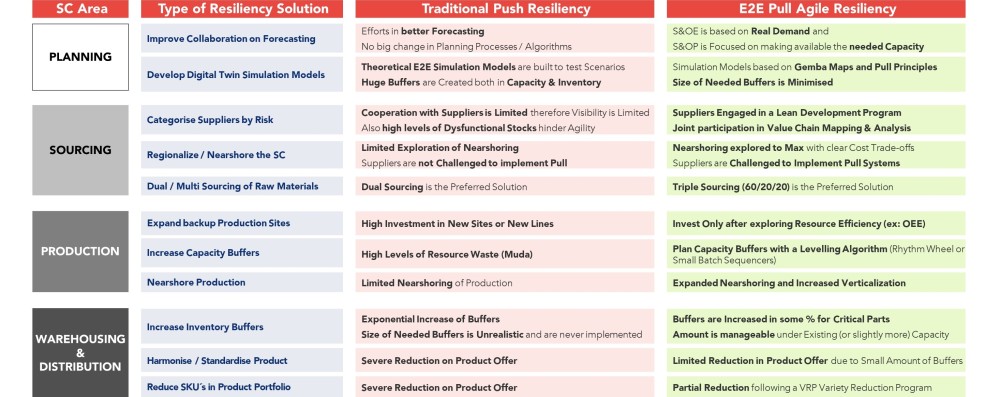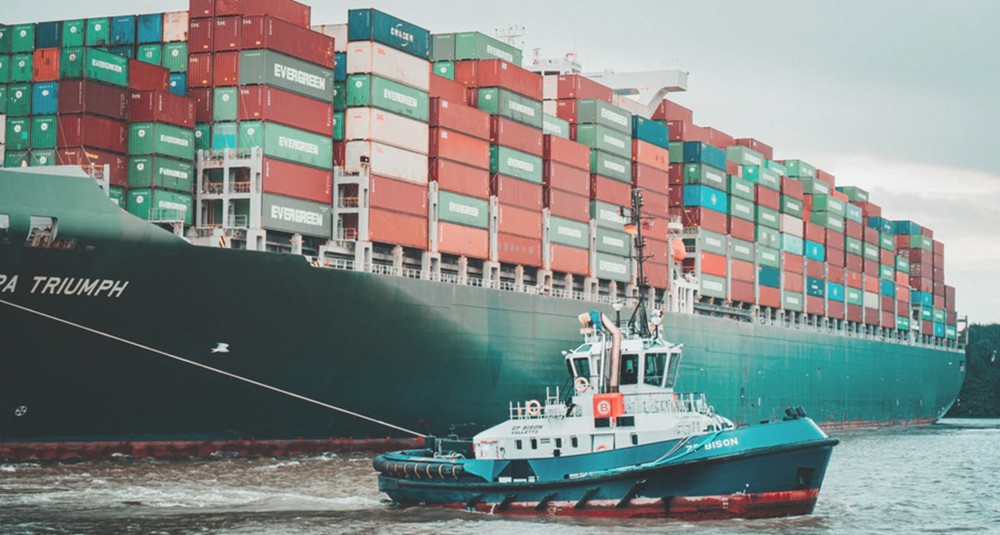In our recent webinar“7 Key Capabilities for a Supply Chain Lean Transformation”we explore Lean Transformation in Supply Chain and its fundamental capabilities. We lay out the process to achieve an end-to-end improvement, demand-driven, and lean-efficient supply chain with a focus on a new paradigm for achieving breakthrough results and competitive advantage in customer service and profitability. In this white paper, we summarise the webinar insights from our Senior Partner and Book Author Euclides Coimbra.
Why do we need to improve the supply chain?
As supply chains are key to operating in a globalised fast-paced market, it is crucial to be aware of the problems, opportunities, and new paradigms that can be applied to make them operate faster, more effectively, and more profitably.
The main reason why supply chains need to be improved is to ensure customer satisfaction, which is a major source of innovation and competitiveness. Supply chains need to become customer-focused, agile, and waste-free, quickly anticipating disruption and instability, and responding to the increasing customer expectations in markets with high demand volatility.
The targets for a Lean supply chain are to improve OTD and OTIF, shorten delivery times, reduce costs to serve, and, most importantly, achieve a radical inventory reduction. They can be achieved by applying the following 7 key capabilities, backed by a strategic value stream analysis, customer-oriented Sales and Operations Planning (S&OP), short and consistent flows, and high resource efficiency.
1. Strategic end-to-end supply chain mapping
Mapping the supply chain from E2E allows for visual identification of critical operations. When understanding logistics loops in the supply chain, it is relevant to consider the key performance metrics to consequently identify where the flow breakers occur.

The most important KPIs in the supply chain are the ones related to the customer, namely OTD, OTIF, and Order-Delivery Lead Time. These happen in the last logistics loop (downstream), where the operations are closer to the customer, for instance, orders’ delivery and transportation – so these should be the first metrics to be optimised.
In the previous loop, the distribution replenishment, the KPIs are related to supply chain flow efficiency, such as inventory flow Lead Time. The second loop regards manufacturing supply and is more difficult to monitor due to the complexity of the production processes. Ultimately, the sourcing and procurement loop refers to the suppliers and material warehouses, and these supply chains upstream must also be analysed, as they affect the customer KPIs.
On top of these four logistics loops, there has to be a consistent supply chain strategy and operations planning, based on an efficient value stream analysis and loop selection, to then move to the project execution phase through the implementation of KAIZEN™ practices.
2. Implement a pull-planning system
The traditional approach to supply chain agility comes from Collaborative Planning Forecasting and Replenishment (CPFR), based on central information systems such as MRPs or DRPs. However, forecasts may have errors, impacting the delivery to the customer negatively. To solve this challenge and to achieve improved synchronisation and levelling, the pull-planning system has been designed – a new paradigm of pull, demand-driven supply chains.
In terms of S&OP, the right approach is a pull capacity planning process that uses aggregated forecasts to set all the capacity needed in the supply chain – the number of trucks, warehouses, lines, etc. However, the actual execution of S&OE is not based on forecasts but on actual orders to replenish or to make to stock/order.
In the distribution centres, on the supply chain loops, the system entails the creation of flow with small-batch agility and the flexibilisation of capacity. This is attained through the establishment of high-frequency replenishment, transport loops, small batches, and the definition of a stock strategy with supermarkets (demand-replenished stocks) and cross docks.
Hence, the new system works across the whole supply chain to create pull with synchronization and levelling. This will increase value-added efficiency, and, ultimately, increase OTIF and resource efficiency, reducing delivery delays and increasing working capital.
3. Create material and information flow
The third key capability concerns the creation of physical flow in production, warehouses, and transportation. In this context, there is a new key paradigm: flow efficiency must first be improved so that this results in improving resource efficiency.
Part of the types of waste defined by Toyota – excess production, material (or information) waiting, and material (or information) transport – must be eliminated when creating efficient flow, and this should be the first step to be taken. Only then the focus should move to the remaining waste related to resource efficiency – people waiting, movement, overprocessing, errors and defects. This strategy of creating flow will redesign the supply chain to new levels of performance.
4. Increase resource efficiency
Once the flow is created, the attention can move to increase resource efficiency. The aim is to optimise OEE in production, efficiency in warehouses and in transportation routes, as well as innovate with digital and automation technologies. To do so, OEE losses – availability, performance, and quality losses; labour losses – poor organisation or ineffective management; and energy & material losses need to be improved.
The key activities to improve OEE are Kobetsu Kaizen, Autonomous Maintenance, Planned Maintenance, Education and Training, Early Equipment Planning, and Safety and Environment. To improve labour losses layout and line/warehouse design, the transformation of operational teams procedures can be supported by Daily Kaizen. For energy & material losses, Kobetsu KAIZEN™ coupled with green frameworks will deliver substantial results.
While implementing these improvement initiatives, the previously designed pull flow system blueprint must be sustained to avoid the automation of waste. It is important to understand which activities in the supply chain are considered waste and which are value-added, to eliminate waste and focus on the value-added part when investing in improved automated solutions.
5. Reinforce the KAIZEN™ culture
The reinforcement of the KAIZEN™ Culture is crucial for the supply chain improvement, aligning the effective functioning of the previously presented frameworks. The most important steps to create a Continuous Improvement Culture are the implementation of Daily KAIZEN™ within teams, learning how to do focused KAIZEN™ events, the creation of a strategy deployment process, and education and training, with a KAIZEN™ Lean Academy that teaches the 7 capabilities of a Lean supply chain.
The Daily KAIZEN™ system has to be adopted by all teams from every level of the organisation, involving all employees in frequent KAIZEN™ actions with a special focus on developing the team leaders. This system encompasses a frequent control of key KPIs to support actions on real data, identify wins and losses, and act quickly with countermeasures when there are problems or disruptions.
6. Increase Supply Chain Resilience
We need a more resilient supply chain. We need to explore the pull system to fight instability and become more resilient. How can we adapt the Lean system to become more resilient?
We can develop a supply chain digital twin model, based on the end-to-end strategic mapping, to gain visibility of the performance of all the elements and loops of the supply chain, including all the existing tiers of suppliers.
We need to setup an Obeya or visual management room for visual risk crisis management. We can think about it as a war room. And we have to implement a Tiered Help Chain process between all the teams that intervene and manage the supply chain.
This is what we call internally: Just-in-time with Just-in-case features. It is much better than the traditional system with “Just-in-case” features. A Resilient Lean System will explore all the features of the Toyota “Just-in-Time” System creating the flow in the logistics loops, like we saw in all the other capabilities.

7. Pilot, assess, benchmark and scale
The last key capability to implement an effective Lean supply chain transformation refers to the need for developing good pilots and assessment maturity models, performing internal and external benchmarking, and quick deployment and scale progress.
The strategic end-to-end Value Stream Analysis pilot workshop goals are to set a vision and business case, define a steady progress roadmap with 3-to-6-month sprint cycles, create a war room for visual project management, and show double-digit business results.
After a successful sprint – the pilot – deploying the new processes within a large organisation can be difficult. To facilitate this process, the Team Development Programme lays out the scaling of the new process in 5 steps:

For additional insights on supply chain transformation, you can read the book KAIZEN™ in Logistics & Supply Chains or email the author: ecoimbra@kaizen.com
#assembly manufacturing #process manufacturing #logistics #warehousing and transport #operations
See more on Assembly Manufacturing
Find out more about transformation in this sector
See more on Operations
Find out more about improving this business area
